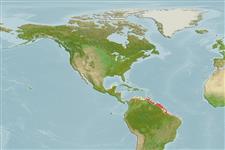Common names from other countries
>
Eupercaria/misc (Various families in series Eupercaria) >
Sciaenidae (Drums or croakers)
Etymology: Lonchurus: Greek, logche = lance + Greek, oura = tail (Ref. 45335).
Environment: milieu / climate zone / depth range / distribution range
Écologie
marin; saumâtre démersal; profondeur ? - 25 m (Ref. 5217). Tropical
Western Atlantic: Colombia (Ref. 5217) to Brazil.
Taille / Poids / Âge
Maturity: Lm ? range ? - ? cm
Max length : 32.0 cm TL mâle / non sexé; (Ref. 9626); common length : 27.0 cm TL mâle / non sexé; (Ref. 3702)
Épines dorsales (Total) : 11; Rayons mous dorsaux (Total) : 32 - 34; Épines anales: 2; Rayons mous anaux: 7. Colour dark greyish above, yellowish to pale below. Pectoral fins long and jet black. Tips of pelvic and anal fins dark. Inside of gill cover black. Eye small, about 8 to 9 times in head length. Mouth small, inferior, enclosed under snout. Chin with 5 pores and many barbels, 3 to 4 pairs in a tuft around median mental pore, 15 or 16 pairs along median edges of lower jaws and subopercles. Pectoral fins greatly enlarged, extending beyond anal-fin base. Gas bladder narrow, about equal to head length, bearing anteriorly 2 pairs of appendages, anterior pair short and horn-like, lateral pair long, tube-like, extends to posterior end of gas bladder (Ref 51721).
Found over mud or mud-sand bottoms of estuaries and adjacent areas (Ref. 5217). Feeds on bottom-dwelling organisms, mainly worms. Marketed fresh and salted.
Life cycle and mating behavior
Maturities | Reproduction | Spawnings | Egg(s) | Fecundities | Larves
Chao, L.N., 1978. Sciaenidae. In W. Fischer (ed.) FAO species identification sheets for fishery purposes. West Atlantic (Fishing Area 31). Volume 4. FAO, Rome. (Ref. 3702)
Statut dans la liste rouge de l'IUCN (Ref. 130435)
CITES (Ref. 128078)
Not Evaluated
Menace pour l'homme
Harmless
Utilisations par l'homme
Pêcheries: intérêt commercial mineur
Outils
Articles particuliers
Télécharger en XML
Sources Internet
Estimates based on models
Preferred temperature (Ref.
115969): 27 - 28.3, mean 27.5 (based on 362 cells).
Phylogenetic diversity index (Ref.
82804): PD
50 = 0.7500 [Uniqueness, from 0.5 = low to 2.0 = high].
Bayesian length-weight: a=0.00851 (0.00413 - 0.01752), b=3.08 (2.91 - 3.25), in cm Total Length, based on LWR estimates for this (Sub)family-body shape (Ref.
93245).
Niveau trophique (Ref.
69278): 3.3 ±0.31 se; based on food items.
Résilience (Ref.
120179): Haut, temps minimum de doublement de population inférieur à 15 mois (Preliminary K or Fecundity.).
Fishing Vulnerability (Ref.
59153): Low vulnerability (22 of 100).
